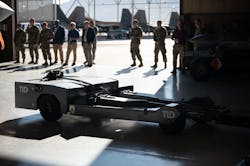Modernizing the Air Force: Bridging the Gap with Industry Innovation

In a dynamic world where military strategy and technology evolve rapidly, the United States Air Force is facing a pressing need for ground support equipment modernization.
Leaders for the Air Force's support group leaders recently shared insights with Airport Business into their ambitious mission to revamp their ground support equipment for the future during the International GSE Expo. This mission, which seeks to bridge the gap between the military's unique demands and cutting-edge commercial technology, is a complex undertaking that involves multiple stakeholders and a long-term vision.
Lt. Col. Jon Van Nostrand, Deputy Division Chief, Support Equipment + Vehicles for the Air Force highlighted the urgency of the situation. "For several decades, the Air Force has been operating with equipment born out of the 1960s and 1970s, which served its missions adequately," he explained. "However, as we anticipate shifting combat scenarios and evolving global challenges, we must ask ourselves if our current equipment is the best fit for the future missions we are likely to encounter."
The Air Force acknowledges that the commercial industry is ahead of them in many technological areas, where they would like to allocate their engineering resources smartly to address unique Department of Defense (DOD) challenges. The need for a deep understanding of industry developments and potential partnerships is paramount.
"A big part of being plugged in here is to ensure we know everything that industry is up to," Van Nostrand, emphasized.
Tahrea Grant, Chief Engineer, Support Equipment Vehicles for Air Force, stressed the critical role of support equipment in the Air Force's operations. "Support equipment is starting to become a limiting factor for us to successfully fight a war, especially given the current global situation," he explained. Their mission involves exploring synergies with the commercial sector to close the gap between industry innovation and military-specific requirements.
One of the primary goals is to maximize commonality in equipment across various Air Force missions and aircraft types. The emphasis is on investing in equipment that can adapt to different aircraft and even different service branches.
"We want to make sure we're investing in maximum commonality where it kind of doesn't matter what aircraft or even what service's aircraft is needed," Van Nostrand said.
Modernizing the Air Force's support equipment presents a complex challenge. Much of the technology in use is decades old, with equipment that was designed in the 1950s and built in the 1960s still in operation today. This outdated infrastructure hampers efficiency, increases maintenance costs and jeopardizes mission readiness.
Leaders expressed concern about the financial burden of sustaining legacy systems. "We are often paying more to sustain some of these legacy systems than those same dollars could be better applied to solving problems in a smarter way through partnerships with industry," Van Nostrand explained.
The urgency for modernization arises from the changing global landscape. The Air Force anticipates the possibility of near-peer conflicts with nations like China and Russia. This potential shift in mission requirements necessitates a thorough reevaluation of equipment capabilities and readiness. "We have to look at ourselves hard and say, look at what China's investing, look at what Russia's investing, look at what we're investing," Van Nostrand emphasized.
One of the critical challenges is the transition from diesel-powered equipment to more environmentally friendly and efficient alternatives, such as electric and hybrid systems. The commercial sector has been rapidly embracing electrification, which offers not only cost savings but also environmental benefits. However, for the military, the shift to electrification comes with unique challenges, including the need to operate in austere environments with limited infrastructure.
The Air Force recognizes the need to align with industry trends in electrification, but they must also address the specific requirements and constraints of military operations. "We are slower than I would like to come to the realization that we need to start posturing ourselves for this," Grant admitted. The industry is moving toward electrification, and the Air Force must keep pace to ensure the availability of equipment and infrastructure.
As they engage with industry, the Air Force acknowledges that the commercial sector already possesses a significant technological advantage. "From a technology perspective, industry probably has the 60 to 70% solution," Grant explained. However, adapting these solutions to meet the military's unique needs requires extensive collaboration and communication.
The Air Force has adopted a multifaceted approach to engage with industry. They communicate their requirements broadly to the industry to solicit potential solutions. At the same time, they engage in in-depth discussions with key industry players to ensure that their vision aligns with the military's needs.
Moreover, the Air Force has been proactive in attending industry events and expos to stay informed about the latest technological advancements. They have even initiated their own event to bring industry partners to their airbase, fostering continued dialogue and collaboration.
The Air Force's mission to modernize its support equipment is a critical and complex endeavor that involves aligning with industry innovation while addressing unique military requirements. With an unwavering commitment to closing the gap between their current capabilities and future needs, the Air Force is actively engaging with industry partners and exploring solutions to ensure their readiness in an ever-changing world.
As they navigate this journey, the Air Force aims to maximize commonality, efficiency, and adaptability, ensuring that their support equipment remains an enabler rather than a limiting factor in their mission success.
About the Author
Joe Petrie
Editor & Chief
Joe Petrie is the Editorial Director for the Endeavor Aviation Group.
Joe has spent the past 20 years writing about the most cutting-edge topics related to transportation and policy in a variety of sectors with an emphasis on transportation issues for the past 15 years.
Contact: Joe Petrie
Editor & Chief | Airport Business
+1-920-568-8399
>> To download the AviationPros media kits, visit: Marketing Resource Center
>>Check out our aviation magazines: Ground Support Worldwide | Airport Business | Aircraft Maintenance Technology
